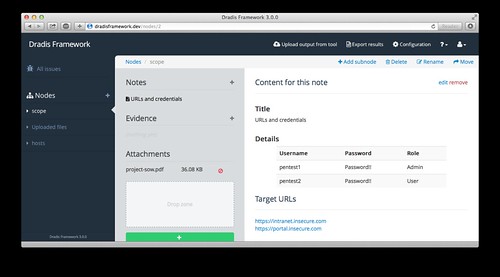http://www.darknet.org.uk/2016/01/dradis-reporting-platform-security-professionals
Dradis – Reporting Platform For IT Security Professionals
Dradis is an open source reporting platform for IT Security, tailored towards the types of information that need to be shared amongst an information security team during a professional engagement. It provides a centralized repository of information using a web interfaced based client/server architecture.
 It also supports 15+ different tools including Burp, Nessus, Nmap, Qualys (listed below).
It also supports 15+ different tools including Burp, Nessus, Nmap, Qualys (listed below).
The goals of the project are to:
Linux – dradis-3.0.0.rc3-linux-x86.tar.gz
Mac – dradis-3.0.0.rc3-osx.tar.gz
Or read more here.
Dradis – Reporting Platform For IT Security Professionals
Dradis is an open source reporting platform for IT Security, tailored towards the types of information that need to be shared amongst an information security team during a professional engagement. It provides a centralized repository of information using a web interfaced based client/server architecture.

The goals of the project are to:
- Share the information effectively.
- Easy to use, easy to be adopted.
- Flexible: with a powerful and simple extensions interface.
- Small and portable.
- You should be able to use it while on site (no outside connectivity).
- It should be OS independent (no two testers use the same OS).
Features
- Platform independent
- Markup support for the notes: text styles, code blocks, images, links, etc.
- Integration with existing systems and tools:
- Burp Scanner
- Metasploit
- Nessus
- NeXpose
- Nikto
- Nmap
- OpenVAS
- OSVDB
- Retina
- SureCheck
- VulnDB
- w3af
- wXf
- Zed Attack Proxy
New in v3.0
- Support for Issue/Evidence separation
- New HTML/CSS interface
- Use BCrypt for password storage.
- Gemified plugins in external repositories
- Enhanced background workers
- New plugins:
- Export: CSV, PDF
- Upload: Acunetix, Qualys
- Rails 4.1
Linux – dradis-3.0.0.rc3-linux-x86.tar.gz
Mac – dradis-3.0.0.rc3-osx.tar.gz
Or read more here.
Comments
Post a Comment